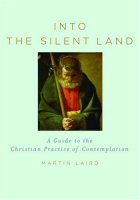 Into the Silent Land: A Guide to the Christian Practice of Contemplation , by Martin Laird (Oxford University Press, 2006)
Into the Silent Land: A Guide to the Christian Practice of Contemplation , by Martin Laird (Oxford University Press, 2006)
The physical benefits of meditative techniques are well established, and I’d like to be able to take advantage of them. What has hindered me is that many—though not all—of the studies have focused on Transcendental Meditation (TM), the Eastern religious aspects of which have led me to keep meditation in general at arm’s length since I first learned of it some 40 years ago. It will not do to gain a physical benefit at a spiritual loss—I can’t help thinking of The Magician’s Nephew, in which Digory was tempted to steal an apple that would have cured his dying mother, but if he had done so, both he and his mother would have later “looked back and said it would have been better to die in that illness.”
Yet Digory, having passed the test, was eventually given another apple, one that healed his mother in the right way.
Despite all the attention given to TM during my formative years, it turns out that Christian meditation is an ancient and respected practice. Many of the techniques turn out to be similar, though not identical and of course the focus and intent are quite different.
You don’t hear much about Christian contemplative practice today, at least not outside of the more liturgical traditions—and not much in them, either. Our cranked-up, frenetic, yammering world is not comfortable with either external or internal silence.
Nor does it help that those who have written about meditation are generally describing the indescribable, which makes them incomprehensible, as far as I’m concerned. I plowed about halfway through Thomas Dubay’s Fire Within: St. Teresa of Avila, St. John of the Cross, and the Gospel on Prayer before giving it up as being 'way too far over my head.
Into the Silent Land covers much of the same material in a shorter and simpler form, but it still leaves my head spinning—and this was my second reading. So I cannot, at this point, give it an accurate evaluation. I will say it’s worth a third attempt at some point. For now, I’ve found a few ideas that I can hang onto and begin to put into practice, which may help illuminate a re-rereading.
Spiritual and physical benefits remain to be seen, but even what little I’ve been able to glean thus far has been of some help with no fewer than three of my New Year’s Resolutions: Learn to Relax, Pay Attention, and Cast Away Fear. (See the Progress section of New Year’s Resolution #11.)
Side note: Do you, like me, assume contemplatives must generally be introverted people? Perhaps it's true; those who choose to be monks would be those who are comfortable with silence and solitude—not that all contemplatives are monks. But having read recently that introverts have more activity constantly going on in their brains—more internal dialogue, measurable in neurological studies—I suspect that we are drawn to meditation because we need it more. We need techniques and much practice to be able to still the chattering mind and achieve inner silence.


